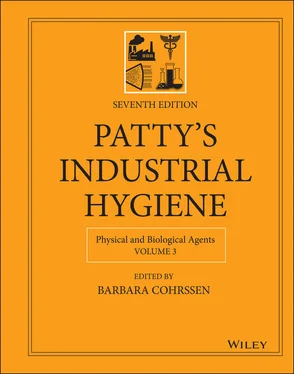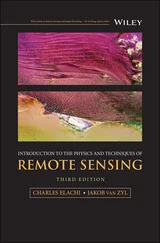where E eff(in W m −2) is defined in Eq. (10). The maximum permissible exposure time for blue‐light sources that subtend an angle greater than 0.011 rad is (20):
(25) 
and the maximum permissible exposure time for blue‐light sources that subtend an angle less than 0.011 rad is (20):
(26) 
Unlike the photochemical effects represented by the actinic UV hazard and the blue‐light hazard, thermal effects do not show a strictly reciprocal relationship between spectrally weighted irradiance or radiance and permissible exposure time. Viewing durations may be limited involuntarily to a few seconds by the aversion response or the sensation of pain. A worker performing a visual task might, however, be motivated to persist in viewing an excessively bright source despite eye discomfort.
5.2 Exposure Geometry
5.2.1 Direction of Irradiation
When possible, potentially hazardous optical radiation sources should be located out of the line of sight of workers. UV sources, which may pose a hazard to the skin as well as the eyes, should be oriented to avoid direct irradiation of exposed skin. An example is the use of upper room germicidal UV radiation, where germicidal lamps are positioned and baffled so as to flood the unoccupied upper space of a room with UV‐C radiation while limiting the amount of reflected or stray radiation that reaches the lowest 2 m (6.5 ft) of the room (45).
If a surface directly irradiated by a hazardous optical radiation source is capable of reflecting radiation into a worker's eye, or onto exposed skin in the case of UV radiation, that surface should be treated with a matte or absorptive finish.
5.2.2 Distance from Source
When the source directly irradiates a worker, increasing the distance of the worker from the source is an effective control measure for optical radiation hazards generally.
UV hazards and IR hazards to the cornea and lens, as well as the blue‐light hazard for small sources subtending less than 0.011 rad, depend on the irradiance received at the eye. If the distance from a source is more than five times the longest dimension of the source, the irradiance received at the surface of the skin or cornea decreases inversely with the square of the distance from source, as stated in Eq. (23). If the exposure geometry does not meet the “five times” rule, the irradiance decreases less rapidly with distance. For example, for a uniform line source of length l and radiant power Φ, the irradiance at a distance r is given by
(27) 
where α is the angle in radians subtended by the source. The angle subtended by a source of length l when its midline is viewed straight on from a distance r is
(28) 
For retinal thermal hazards, the maximum allowable thermal‐hazard‐weighted radiance is inversely proportional to the angular subtense of the source (Eq. (16)). Increasing the distance from the source reduces the angular subtense, potentially increasing the allowable limit for the retinal‐thermal‐hazard‐weighted radiance.
The allowable limit for the blue‐light hazard for sources subtending an angle greater than 0.011 rad is a blue‐light‐weighted radiance of 100 J cm −2sr −1. This limit is not altered by changing the distance from the source unless the change reduces the angular subtense of the source below 0.011 rad. The size of the area on the retina affected by an overexposure would, however, be reduced if the angular subtense were reduced by any amount. Increasing the viewing distance r from an excessive blue‐light source could, therefore, limit the areal extent of potential damage to the retina, even if the risk of incurring some photochemical damage remained unchanged.
5.2.3 Proximity to IR Sources
Erythema ab igne is a reddening of the skin caused by proximity to a radiant heat source. Traditionally caused by prolonged sitting close to a fire ( ab igne is Latin for “from fire”) or by close work with hot objects in foundries, glassworks, and bakeries, this condition has also been reported as a result of exposure to electric space heaters (46) and a laptop computer (47). Workers should avoid direct skin contact with laptops and the common practice of locating space heaters very close to their legs and feet.
Shielding for optical radiation includes enclosures around sources, protective clothing and eyewear, and barrier creams (such as sunscreens) applied to exposed skin. Shields attenuate radiation by absorbing or reflecting it. Because absorption and reflection tend to be wavelength dependent, shields should be selected based on their ability to attenuate radiation in the spectral range(s) of concern. It should be noted that shields attenuate radiation but might not entirely block it. The transmittance of a shield in the spectral region of concern should be small enough that the transmitted radiation reaching the skin or eye will be below the applicable exposure limit.
5.3.1 UV Shielding
5.3.1.1 UV‐Protective Properties of Shielding Materials
Rigid materials that are transparent to visible radiation but attenuate UV to some extent include glass and polycarbonate. Crown glass used in eyeglass lenses transmits close to 90% of UV radiation at wavelengths longer than 340 nm, about 50% of radiation at 310 nm, and 10% of radiation at 295 nm (48). Polycarbonate plastic has better UV‐shielding characteristics but still transmits about 10% of radiation at 320 nm and 50% of radiation at 350 nm (48). CR‐39 (allyl diglycol carbonate), another plastic used for eyeglass lenses, transmits about 10% of radiation at 360 nm and 50% of radiation at 375 nm (48). UV absorption by glass or plastics may be enhanced by UV‐absorbing additives or films. The UV protection afforded by sunglasses is not indicated by the darkness of the tint (49).
The UV‐shielding properties of fabrics depend on a number of characteristics, including fiber type, color, thickness, weight, and density of the weave or knit (50). Ultraviolet protection factor (UPF) for a fabric is defined as the inverse of the fraction of erythemal‐weighted solar spectral irradiance between 290 and 400 nm that is transmitted through the fabric. For example, if the weighted irradiance transmitted through a fabric is one‐tenth of the weighted irradiance incident on the fabric, the UPF for that fabric is 10. Wool, silk, nylon, and polyester generally have higher UPFs than cotton, linen, or rayon. UPFs tend to increase with darker color, tighter weave, heavier weight, and greater thickness. Bleaching a fabric reduces its UPF by removing UV‐absorbing impurities. Washing increases the UPF of cotton fabrics, probably by tightening the weave or knit through shrinkage (50). Wetting may decrease UPF, and though UPF is a good predictor of the protection afforded by loose‐fitting clothing, it may underestimate exposure to the skin under tight‐fitting clothing (51). Because UPFs are determined using simulated solar UV radiation, they might not accurately represent the degree of protection afforded against UV radiation of wavelengths less than 290 nm, such as germicidal UV radiation. Also, the UPF for a fabric does not provide a good measure of protection against the effects of UV‐A radiation, including photoaging and reaction to photosensitizers (52). The general principle of selecting tightly woven fabrics or leather for good protection should, however, hold true throughout the UV spectrum.
Читать дальше
















